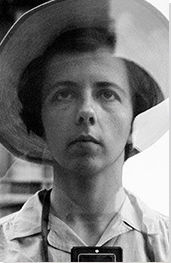Summary of Vivian Maier
Unknown in her own lifetime, Maier left behind a body of work that has seen her name take on near fabled status. A "difficult" woman with few (if any) close friends or lovers, she is often referred to as the Mary Poppins of Street Photography on account of the fact that she spent most of her career working as a nanny. In her down time, however, Maier would explore urban locations where she found her subjects: the ordinary people living at the margins of society. Her earlier years remained faithful to a monochromatic documentary style but, she later adopted color which widened the scope of her oeuvre to allow for an element of symbolism. She also produced a number of self-portraits (black-and-white and color) which have given the world a picture of an otherwise unknown, intensely private figure. The publication and exhibition of her work, very little of which was processed or printed in her own lifetime, has led to legal, academic and ethical questions about the posthumous exposure of an artistic vision that has seen her hold her own alongside the likes of Robert Frank, Diane Arbus and Garry Winogrand.
Accomplishments
- Maier has been likened to the top Street Photographers in the way her work explores the relationship between the image taker and their urban subject. It is known, however, that Maier took special pride in her working-class roots and, as someone who earned her keep as a domestic help, she shared a special empathy with many of her subjects. This bond is revealed time and again in the faces of those honorable subjects who filled her sympathetic viewfinder.
- Maier was unique amongst Street Photographers in the way she was able to interact with children, be they posing for portraits or caught in spontaneous moments of play. Her affinity with a child's worldview (most of her photographs of children are shot from the eye-level of the child) no doubt stemmed from her affection for children which was fostered in her "day job" (as a nanny).
- Known primarily for her street portraits, Maier proved highly adaptable and she possessed a rare ability to pick out patterns between human figures and their architectural surroundings. It would be too easy to dismiss her as an accomplished amateur given her ability to identify compositional possibilities using light and shadow, surface reflections and considered points of view. Indeed, her archive demonstrates that Maier was a learned and adept urban photographer even though she received no formal training.
- In her later years, Maier turned exclusively to color photography, and having done so, some commentators have suggested she unwittingly predicted the shift in attitude that allowed color photography to be considered artistically credible. On a personal level, the move away from her monochromatic phase saw Maier replace the human figure with color as the "protagonist" in her images. For this reason, her mature works allow for more abstract formal elements to dominate her frame.
- Maier was discovered after a vast cache of her unprinted works was acquired by third parties through auction. Given that she has had no say in how her images have been selected or represented in public, the posthumous exhibition and publication of her work raises complex questions about the ethics of artistic reputation building. Indeed, Maier's legend has been built in her absence by curators who have profited financially (and lawfully) from an artist who showed little or no will to sell or exhibit her work, and who died in poverty.
The Life of Vivian Maier
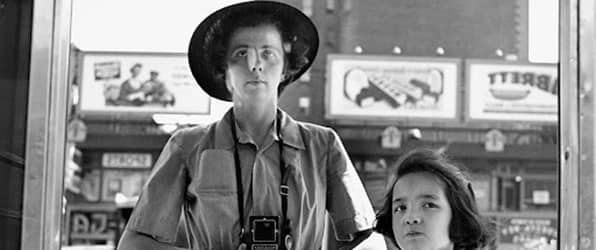
Undiscovered until after her death, French-American nanny Vivian Maier’s vast output of urban documentary photographs offer an honest glimpse of the world as seen through the eyes of a woman who was at once reclusive, private, and eccentric, yet also curious, caring, and cheeky.
Important Art by Vivian Maier
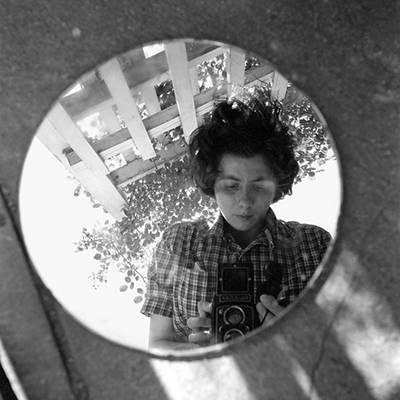
Untitled (Self-Portrait)
A significant number of Maier's photographs were self-portraits, though one could hardly accuse her of ever being self-absorbed of narcissistic. With her short haircut and functional style of clothing, she often appears as an anonymous, almost androgynous, presence in reflected objects such as windows, mirrors, or hubcaps, or sometimes just in shadow. The art critic Jillian Steinhauer has made the point that "in many cases, Maier didn’t even see her own pictures beyond framing them in her viewfinder", and asked "Who's to say she would have wanted the whole world looking at them?". However, Jeff Goldstein, one of the major collectors of Maier’s work, wrote that between 1950-53 Maier did in fact make several self-portrait prints. Indeed, Goldstein states that of the 6000-plus prints she did produce, he found the self-portraits from this period to be "some of her most compelling images" and that she must have thought so too (or else why would she have printed them?).
Critic Alberto Mobilio agreed. He wrote that Maier's propensity for taking self-portraits "confirms without a doubt her own vigorous consciousness of herself as an artist" at the same time as it "testifies to her acute awareness of self-portraiture's long tradition, and particularly its more inventive [...] Permutations". Curator and photography writer Elizabeth Avedon added, "The strength of Maier's character is found in the persona looking back at us. There is little compromise; and ironically for such a private, autonomous person, her self-portraits are some of her strongest work". Reading from a gendered perspective, meanwhile, photographer Mary Thomas views Maier's self-portraits as "historically important" in that they demonstrate "a rejection of gendered expectations" and shed light "on the invisibility of the unmarried, childless woman and child care worker" and that, finally, her self-portraits "question the very ideals Americans cherished at that point in time".
Photograph - Maloof collection
Untitled (May 5,1955, New York City)
Artist and photography critic Allan Sekula notes, Maier "showed the world of women and children in a way that is pretty much unprecedented". A notable characteristic of Maier's photographs is her ability to enter into the psychological space of children, whether they are posing for a portrait at a close distance, or being captured in moments of play in the city streets. In this way, Maier's work bears a strong resemblance to that of Helen Levitt, who is known for her documentary photographs of community street life, particularly of children playing in their neighborhoods.
While many of Maier's photographs of adults indicate no awareness of her presence on the part of her subjects (or if they do register her presence, it is usually with a look of distrust or disdain), her photographs of children frequently involve direct eye contact and expressions of acceptance, bordering on curiosity, on the faces of the young subjects. Here, Maier has captured a fleeting, yet intimate, moment of connection, photographing a boy who is so interested in her presence that he presses his nose against the glass to peer at her more intensely. Moreover, much of Maier's oeuvre seems to indicate the ongoing perspective of the child's point of view, with her photographs of children being shot frontally, at their eye level, and with many of her photograph of adults being shot from below, as if from a child's vantage point.
Photograph - Maloof collection
Untitled (Sept 24, 1959, New York City)
Much like Diane Arbus, Maier took a great many photographs of marginalized people, including racial minorities and the socially deprived. In this image, Maier brings us close to an unknown male, whose unkempt and disheveled appearance signify that he is impoverished; either a manual laborer or a homeless man. Collector John Maloof argues that Maier's apparent "affinity for the poor" is likely due to "an emotional kinship she felt with those struggling to get by". One of Maier's former employers, Karen Usiskin, notes, meanwhile, that "she had a real identity with being a poor person. That was something that she was proud of".
Photographer Mary Ellen Mark has compared Maier's work to that of Swiss-American street photographer and filmmaker Robert Frank in that both foregrounded in their work a sense of alienation and hardship in America. In this way, her work is also reminiscent of that of Richard Avedon, particularly his gritty, high-contrast, close-up photographs of working-class and otherwise downtrodden Americans (as seen in his series In the American West (1985)).
Like Arbus, Frank, and Avedon, Maier tested the space between the photographer and her or his subject. Photographer Anna Fox suggests that "As a woman you have a privileged position. Women develop relationships with people they are photographing, and are less threatening with a medium format camera. There's a subtle irony and gentleness that is a particular female gaze". Curiously, it is in her portraits that we see Maier's subjects offering a glimpse of their inner emotional states and vulnerability, whereas the more affluent individuals she photographed seem, by comparison, guarded and emotionally opaque. As curator Anne Morin observed, "Occasionally [Maier] would make portraits of rich people. But these photographs feel very different. There's something very aggressive about these pictures. She is very close to them and right in their face [but it's] like she's stealing something from them". The man in this photograph does not appear to view Maier with suspicion or contempt, but offers rather a softened expression of acceptance mixed, albeit, with palpable sense of curiosity.
Photograph - Maloof collection
Untitled (7 April, 1960, Florida)
Even though Maier struggled to make or maintain close personal relationships, many of her photographs indicate an interest in tender moments between others. Street photographer Joel Meyerowitz has said that Maier's work was "suffused with the kind of human understanding, warmth and playfulness that proves she was 'a real shooter'", and that she was alert to "moments of generosity and sweetness".
In this photograph Maier has captured just such a moment of sweet tenderness, with the elderly couple seated on the trolley, dozing off while resting their heads against one another. The simple composition focuses the eye on this tender moment, with the trolley's windows and roof rails leading to a vanishing point directly behind the couple's heads. Arts editor Nora O'Donnell has observed that many of Maier's most poignant photographs are casual shots of passers-by caught in transient moments "that nonetheless possess an underlying gravity and emotion". Art critic Roberta Smith added that Maier's photographs "maintain a distinctive element of calm, a clarity of composition and a gentleness characterized by a lack of sudden movement or extreme emotion".
Photograph - Maloof collection
Untitled (June 25, 1961)
Collector John Maloof notes that from an early age Maier "developed an uncanny ability to recognize patterns, to arrange and compose space, and eloquently distribute light and gesture within the frame". Her playful and experimental approach to composition is highly reminiscent of the work of Hungarian-American photographer Andre Kertesz, who also focused on the formal possibilities afforded by light, shadow, reflection, and unconventional vantage points.
While much of Maier's work focused on portraiture, a number of her images were either devoid of human subjects, or made human subjects secondary to the patterns and forms created by urban architecture and found objects. In this photograph, for instance, a group of sailors are shown in Chicago's Union Station. Strong shadows and beams of light dominate the frame as architectural elements preplace the sailors as the image's protagonists. Indeed, Maloof first encountered, and became somewhat awe-struck, by Maier's work when he was searching for source material for a book on historical Chicago architecture. He notes that Maier's body of work demonstrates an innate talent for composition and framing, and that many of the negatives he found in her belongings required little to no cropping during processing.
Photograph - Maloof collection
Untitled (April 19, 1971, Chicago)
Photographer Mary Ellen Mark compares Maier's photography to that of Austrian-American photographer Lisette Model. In particular, both Maier and Model demonstrate a powerful sense of humor, and striking resemblances can be found in many of their images, specifically those of people with interesting body shapes, and of grotesquely made-up upper class women. Arts writers Richard Cahan and Michael Williams assert that "Like other street photographers, [Maier] was on the prowl for metaphor, outrageous juxtaposition, and humor", and she is said to have had "a taste for the grotesque, the bizarre, the incongruous".
In this image, a humorous and jarring juxtaposition is established between the two male figures, one of whom nearly fills the frame with an obese body shape that threatens to burst out of its clothing, and the other, more slender man squeezed off to the side of the frame. This odd scene is amplified by the less-than-pleased, impertinent sideways stare that the unwitting subjects shoot back at the photographer.
Cahan and Williams also note that, like other street photographers, Maier "could make herself invisible [...] But by making eye contact, Maier broke a common rule of documentary work. Some suppose that Maier's choice of equipment may have helped make these pictures possible because she could peer down into the viewfinder of her waist-high camera instead of making eye contact. [But on] almost every roll of film, Maier produced at least one eye-to-eye photo [...] It is the one constant of her work".
Photograph - Maloof collection
Untitled (August 1975, Chicago)
Around the mid-1970s, Maier stopped using her Rolleiflex camera altogether, and turned exclusively to color photography using Ektachrome film. Some critics have recognized a strong similarly between Maier's color photography, and that of German-Canadian street photographer Fred Herzog. Both Maier and Herzog made color the protagonist of their images, creating striking compositions from simple scenes such as groupings of interestingly-colored cars, or bold color choices in the clothing of quirky pedestrians.
Photographer Joel Meyerowitz calls Maier "an early poet of color photography," and curator Anne Morin notes that Maier's color photographs "focus on the musicality of the image, the forms, the density of the colors. She was really working in the medium of color when she took color photographs [...] I think the color work announces the end of her life. She's about to finish making photographs and about to disappear from the world. As her identity is fading, we can feel that fading through the growing abstraction in her images".
Indeed, in this image it is apparent that Maier approached the medium of color photography quite thoughtfully, by selecting scenes and subjects for images in which color (yellow in this example) plays a primary, rather than secondary role. For instance, it is likely that Maier would not have even shot this scene if she had been armed with a black-and-white camera at the time, as the noteworthy and comical aspect of the image derives from the very fact that the three figures all dressed themselves in the same vibrant, one might say, tawdry, shade of yellow.
Photograph - Maloof collection
Biography of Vivian Maier
Childhood
Vivian Dorothy Maier was born in New York to a French mother, Maria Jaussaud Justin, and an Austrian father, Charles (Wilhelm) Maier. Her mother (like her grandmother) worked as a residential servant while her father was a steam engineer. Maier is known to have had one older brother, Karl, from whom she is thought to have been estranged throughout her life. One year before Vivian was born, Karl was placed briefly in the Heckscher Foundation Children's Home before being put in the care of his paternal grandparents. Karl had been removed from his parents' charge due to "constant conflict" and it is known that he suffered mental health issues and was imprisoned several times throughout his lifetime.
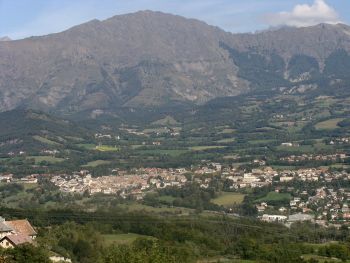
Around the age of four, Maier's father - who had been denounced by his own mother as a "gambler and drunkard" - left the family and she remained in her mother's care, living alternately in the United States, and in the French alpine village of Saint-Bonnet-en-Champsaur where her mother's extended family resided. The Maiers spent some of their time in the United States living with Jeanne Bertrand, a French-born professional portrait photographer and sculptor. Records suggest that Maier and her mother lived with Bertrand in both Boston and the Bronx, New York. For reasons that are undocumented, when Maier was nine years old, her mother falsely reported to the census that Charles was living once again with the family in New York.
Education and Early Training
Maier likely gained an early interest in photography (and perhaps some informal instruction) from Bertrand, although there is no recorded information to corroborate this. In any case, it appears that Maier was self-taught, drawing insights into photographic practice from images she saw at the exhibitions she frequented, by photographers like Brassaï and Henri Cartier-Bresson.
By 1943, Maier (then aged seventeen) was no longer living with her mother, and was residing with a married couple who fostered children in Jackson Heights, Queens, named John and Berthe Lindenberger. When John passed away, Maier stayed on for some time with Berthe. She took on a second job, working at the Madame Alexander Doll Factory. Later in the decade, Maier returned to France where she began practicing photography using a Kodak Brownie camera with 6x9 film format, and no option for adjusting shutter speed, focus, or aperture. It would not be long, however, before she would switch to using an expensive Rolleiflex with square format film.
Mature Period
In 1951, Maier returned from Europe. She made a brief trip to Canada, and then set about looking for employment in the United States. After working briefly in a sweatshop in Manhattan, she moved into the home of a family with a young daughter in Southampton and worked for them as a nanny until 1956.
Maier then moved to the North Shore suburbs of Chicago, and gained employment as a nanny for the Gensburg family, who had three young boys. At the Gensburg home, she enjoyed the use of a private bathroom-cum-darkroom for processing her photographs. She was a solitary person with few to no friends or sexual partners, and enjoyed attending the cinema and theatre alone (which helped her improve her spoken English).
Maier sometimes brought her young charges along with her on photography excursions, travelling by bus or train to the inner city. She would tell the children "Don't tell your parents where we went" but it was important for her to introduce them to a world beyond their affluent neighborhood. On one occasion, she was returning home with the Gensburg boys by train after taking them into the city when one of the boys remarked: "Look, Vivian! The closets are hanging outside!", as he had never seen clothes drying on a clothesline. She asked him "Do you really think everybody has a dryer and a washer?" to which the child confirmed he had thought that. Later that night she relayed this story to Mrs. Gensburg suggesting that her son's attitude was "just terrible". Despite their age and class differences, The Gensburg brothers and Maier would carry their close affection for one another into the boys' adulthood and Maier's old age.
The Gensburg family describes Maier as being "like a real, live Mary Poppins", noting that she never spoke down to the children. She was also described as private, a Socialist, a Feminist, and a very direct person. Other employers described her as being prone to irritability, mood swings, and angry outbursts, bordering on abusiveness at times. It is also claimed that she was extremely secretive, bordering on paranoid, and constantly worried that her employers were entering her quarters.
In the late 1950s, Maier received a sizeable sum of money from the sale of a farm in France that she had inherited from her great-grandfather, Germain Jaussaud. She used these funds to finance solo trips, first to South America in 1957, and then around the world between 1959 and 1960, photographing urban scenes in cities in the Philippines, Thailand, China, India, Syria, Egypt, and Italy. In the following years, she also made trips around the United States, Canada, the Caribbean, and South America.
In the 1970s, Maier worked briefly as a housekeeper for talk-show host Phil Donahue. In her living quarters, she kept boxes of her photography work, as well as her collections of newspaper (stacked in "shoulder-high piles") and audiotapes. The tapes are mostly descriptive comments about her shooting practice ("first time with cue light" for instance) though in one recording she is heard saying "Women are supposed to be opinionated, I hope". By this time Maier had switched from black-and-white to color photography, primarily using a Kodak Ektachrome camera with 35mm film, as well as a Leica IIIc, and sometimes various German SLR cameras. Her work became more abstract too, even focusing occasionally on found objects.
Late Period
The three Gensburg brothers, who had kept in contact with Maier throughout her life, assisted her in her old age. However, she grew increasingly destitute, and lived for a time in a cheap apartment in the Cicero suburb of Chicago, keeping most of her belongings (including her photographs and negatives) in five storage lockers at the Hebard Storage facility on the North side of Chicago.
When she was about to be evicted, the Gensburg brothers made arrangements for her to move to a less dilapidated apartment on Sheridan Road, in the Rogers Park neighborhood of Chicago. Nevertheless, Maier fell behind in her rental payments for the storage lockers, and in 2007, the storage company auctioned off the four tons of negatives, print, and audio recordings that had been housed there. The buyers of Maier's storage locker contents included photography collectors John Maloof, Ron Slattery, and Randy Prow. Slattery was the first to publish some of her works online, but they received little response. Maloof had purchased the greater part of Maier's archive - some 30,000 negatives - as he was working on a book about the history of Chicago's Portage Park neighborhood. He later purchased more of her prints from another buyer at the original auction.
Local residents remember Maier in her later years, as she spent most days sitting on her favorite bench at a local park, often yelling erratically at passers-by, and sometimes going through nearby garbage bins and dumpsters. In November 2008, while at the park, Maier slipped on ice and hit her head, and was rushed to the hospital. She failed to make a full recovery, and was moved to a nursing home in January 2009. She passed away a few months later.
The Legacy of Vivian Maier
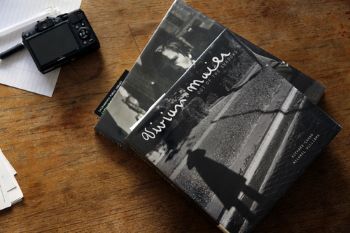
Maloof had made attempts to learn about Maier's life but was not able to find any information until he came across her obituary in the Chicago Tribune (dated April 23, 2009): "Vivian Maier, proud native of France and Chicago resident for the last 50 years died peacefully on Monday [...] Always ready to give her advice, opinion or a helping hand. Movie critic and photographer extraordinaire. A truly special person who will be sorely missed but whose long and wonderful life we all celebrate and will always remember". With Maloof's help, Maier was to become remembered in ways the Chicago Tribune could never have predicted. Yet her posthumous fame has given rise to ethical and philosophical debates.
In October 2009, Maloof published several of Maier's works online, and this time the images "went viral", drawing responses from thousands of people. Maloof currently owns some 150,000 negatives, 3,000 vintage prints, hundreds of rolls of film, newspaper cuttings, books (Maier was an avid reader, and was particularly fond of biographies and autobiographies) and assorted documents (including bills and correspondences). Maier's obsession with documenting Chicago's disenfranchised community and the demolition of some of its historical landmarks (in the name of redevelopment) even extended beyond still images to include a number of homemade movies and audio tape interviews.
In early 2010, art collector Jeffrey Goldstein purchased several of Maier's works from Randy Prow, and through subsequent acquisitions, his Maier collection has grown to include some 17,500 negatives, 2,000 prints, and 30 homemade movies. In December of 2014, Goldstein sold his collection of Maier's black-and-white negatives to the Stephen Bulger Gallery in Toronto. In the 2014-15 academic year, the School of the Art Institute of Chicago inaugurated the Vivian Maier Scholarship Fund. Supported by donations by Maloof, filmmaker Charles Siskel, and gallerist and photography dealer Howard Greenburg, the fund was established to support female students based on financial need.
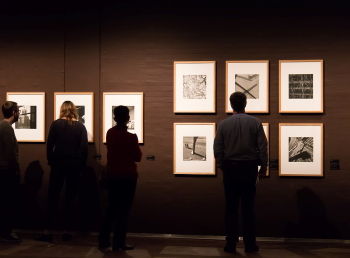
Maloof (with other collectors and curators) has been criticized for making aesthetic choices on how Maier's work should be represented (not to mention profited from). Those who knew her, have complained that Maier would have had profound objections to her work being exploited in this way and that photography was merely a symptom of her pathology that took in other obsessive traits too. Defending his actions, Maloof, while in the process of making his 2013 documentary Finding Vivian Maier, discovered on a trip to the village of Saint-Bonnet-en-Champseur in France, that Maier had been in correspondence with a photographic printing service - thus offering evidence that she was at least considering the possibility of her work being exhibited publicly.
Those moral objections notwithstanding, photographer Anna Fox asserts that "Every street photography book will have to include [Maier] from now on". Art critic Roberta Smith added that Maier's work "may add to the history of 20th-century street photography by summing it up with an almost encyclopaedic thoroughness, veering close to just about every well-known photographer you can think of, including Weegee, Robert Frank and Richard Avedon, and then sliding off in another direction". To the next generation of street photographers, Maier's work provides an historical example of the way in which everyday scenarios can be imbued with a particular aesthetic power, and that through thoughtful framing and composition, the photographer might then find a way of using their camera to capture something of the psychological space of their subjects. But, as Fox and several others have also observed, the most interesting part of Maier's narrative extends beyond her photography to accommodate the mythology that tells us of an extraordinary secret life.
Influences and Connections

- Jeanne Bertrand
Useful Resources on Vivian Maier
- Vivian Maier: A Photographer FoundOur PickBy John Maloof
- Vivian Maier Developed: The Untold Story of the Photographer NannyOur PickBy Ann Marks
- Vivian Maier: Out of the Shadows, 2nd EditionOur PickBy Richard Cahan and Michael Williams
- Vivian Maier: A Photographer's Life and AfterlifeOur PickBy Pamela Bannos
 Ask The Art Story AI
Ask The Art Story AI